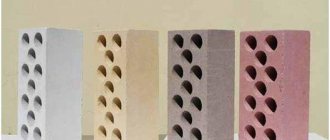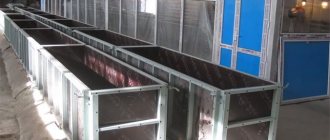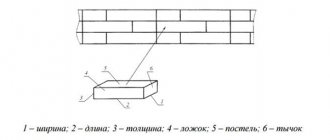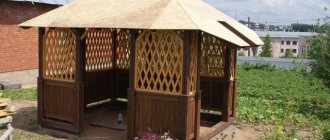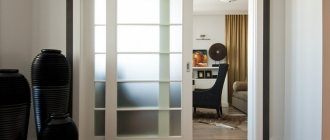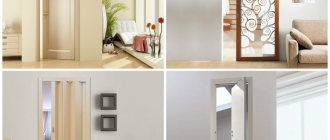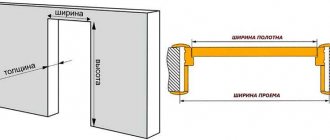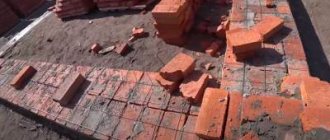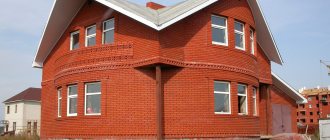Facing brick, unlike ordinary brick, has the correct shape, even angles, and an ideal front surface.
Facade bricks come in various shapes and have different compositions, and the range of colors and textures has no boundaries.
The shape of facing bricks has standard values, although some manufacturers produce exclusive types that do not correspond to generally accepted dimensional parameters.
The length of the facing blocks can be one-and-a-half, single or double.
For accelerated construction, one-and-a-half or double elements are used.
One and a half facing brick
Due to the presence of a wide front side, one-and-a-half bricks help to significantly reduce installation work. The front part can be smooth, textured or embossed . Compared to single elements, the front part of one-and-a-half bricks is thicker, which is why one-and-a-half bricks are called thickened.
1 m³ of masonry with one-and-a-half elements is 378 bricks. The standard size of one element is 25x12x8.8 cm. There are other sizes, for example, the European standard 25x8.5x6.5 cm.
According to the physical component, one-and-a-half blocks can be silicate or ceramic. The composition of the material depends on the production method, as well as on the nature of the raw materials.
The mass of one one-and-a-half element varies within three and a half kilograms . The material has high fire resistance. There are hollow elements that are much lighter; accordingly, such masonry has a much reduced load on the foundation part of the structure.
Types of finishing bricks
The following types of bricks are available on the building materials market:
- white (silicate);
- ceramic;
- clinker;
- hard pressed brick.
Each of them has its own pros and cons.
Silicate
Such products are often used for exterior decoration, because the cost of the material is one of the most affordable. The manufacturing method is that a solution of lime, quartz sand and special components undergoes dry pressing with a gradual increase in temperature.
The advantages of sand-lime brick are as follows.
- Frost resistance. Brick can withstand a huge number of freezing and thawing cycles.
- Safety. The structure, methods, techniques and sequence of production do not affect environmental friendliness; as a result, the products do not have a negative impact on health.
- Availability. This is the most inexpensive material available.
- Optimal strength. The resulting surface can withstand all kinds of weather conditions, provided that it is laid correctly.
Let's also mention the disadvantages.
- Decent weight. Due to this, the load on the foundation increases; as a result, in order to cover the surface with silicate bricks, the structure must be thoroughly strengthened.
- Little visual appeal. The material has no texture, and even the dye does not give the desired result.
- Thermal conductivity. This product has a high characteristic; as a result, in difficult natural and climatic conditions, additional insulation is required.
Ceramic
This product is the main competitor of the above, so the question often arises which brick is better: ceramic or white (silicate). Of course, it is more difficult to produce ceramics; the difficulty lies in choosing the appropriate raw materials. For production, only high quality clay with small admixtures of other components is used. Since the color of the material is often red, the final product turns out to be exactly this color, but other varieties are also found.
If necessary, the raw materials can be dyed. The production method is that the mass is first shaped and then sent to a highly heated oven. Actually, the level of quality of the product depends on the correct preparation of the mixture and its firing.
READ MORE: Asynchronous motor with squirrel-cage rotor design operating principle
If the product has burnt zones, then it was exposed to high temperatures, the brick will be brittle. With insufficient temperature and insufficient firing time, the product comes out faded, has high moisture absorption, and there is no ringing when struck.
The advantages are as follows.
- Appearance. Ceramic bricks may vary in color, size and configuration. This facilitates the implementation of various design tasks.
- Life time. The durability of the surface made from this product is estimated at more than tens of years.
- Sound and heat insulation. The product perfectly retains heat, protects against the penetration of extraneous noise and cold.
Such a decorative product has a surface that is more similar to natural stone. For production, a fraction of natural materials, cement, shell rock and pigment minerals are used. The mixture is pressed and exposed to high temperatures.
Hard pressed facing bricks have many advantages: strength and long service life, the coating perfectly withstands a large number of temperature cycles. But due to its considerable mass and high cost, the product is not in great demand.
Clinker
It is somewhat similar to ceramics, but for its production a more refractory type of clay is used, and firing is carried out at extremely high temperatures. Thanks to this, the product acquires excellent protective and decorative properties. But this also affects the final price: it increases greatly.
Advantages and disadvantages
The main advantage of one-and-a-half elements is the reduction in the duration of installation work.
Other advantages of cladding from one-and-a-half blocks:
- a smaller amount of solution is required for work;
- due to its size, the material is more economical than single. In total, the cost of façade cladding is lower, despite the fact that for each element a single element is inferior in price;
- has better insulating properties.
In addition to the specific advantages of a particular type of element, brick cladding has characteristics that define the material as reliable and durable:
- frost resistance;
- fire resistance;
- strength;
- long operational period;
- good thermal insulation properties;
- sound absorption;
- environmental friendliness.
Brick cladding reliably protects the walls of the house from external influences, and does not require special care or additional maintenance throughout the entire operational period.
The disadvantages of one-and-a-half facing bricks include quite high costs, as well as, depending on the type of material, the possibility of efflorescence on the surface.
Scope of use
The scope of use of the building material in question is very wide. The reason for this demand is that one-and-a-half ceramic bricks have excellent qualities and a low price. Most often, the material is used in the construction of external and internal walls of houses, as well as in the arrangement of partitions.
You can learn about the benefits of sand-lime brick from this article.
Solid materials are used in the construction of plinths and foundations. If we consider slotted one-and-a-half bricks, then they are used for the construction of lightweight walls, light partitions and other structures that will not be subject to heavy loads. Also used to fill the frames of multi-level high-rise buildings.
READ MORE: Dimensions of curbs according to GOST and standard installation instructions
Thanks to the wide range of products: white, colored, hollow, solid, it allows you to approach the construction of a house creatively. Sesquisilicate is actively used in laying external and internal walls. If you combine single and one-and-a-half, white and colored stones, you can get a very original decoration for the facade of the house. Since sand-lime bricks are supplied in packs and on pallets, it is possible to organize house masonry work very flexibly.
Yellow brick facing photo and other data are described in the article.
But there are certain conditions under which one-and-a-half silicate bricks should not be used. As a rule, this is due to climatic conditions or features of the structure being built. If it is exposed to a temperature of 600 degrees, the tensile strength of the artificial stone is reduced, resulting in the formation of cracks on its surface.
You can read about the weight of red solid brick 250x120x65 in the article.
You can learn about the weight of red brick from this article.
One-and-a-half silicate brick is an excellent building material in terms of its performance. It is very often used in the construction of fences and partitions. Another advantage of this stone is its low cost, as a result of which you can build houses profitably, saving money on the purchase of material.
Other types of facing bricks
In addition to one-and-a-half elements, single or double bricks are used for cladding . Single ones have standard dimensions of 25x12x6.5 centimeters. Double - 25x12x138 centimeters.
Bricks are also classified according to their filling: they can be solid or hollow. Hollow cladding elements significantly reduce the load on the foundation part of the building.
Depending on the raw materials and manufacturing method, facing bricks, regardless of the size of the element, can be:
- silicate;
- ceramic;
- hyper-pressed.
Each type has its own characteristics, so the choice must be focused not only on the size of the brick, but also on the composition and structure. The color of the material is also important to ensure decorativeness .
Sand-lime brick and its standard sizes
Brick sizes are regulated by All-Russian GOST standards. Dimensions of sand-lime brick (single) - 250x120x65 mm. As for the other models, the one-and-a-half brick, bed size is the same as an ordinary stone, only it is thicker - 250x120x88 mm. A double brick has, accordingly, doubled height and dimensions - 250x120x140 mm. The thickness of a wall or partition is taken to be a multiple of the length and width of the brick. So, a wall of one brick has a thickness of 250 mm, and a wall of one and a half bricks has a thickness of 380 mm (250 mm + 120 mm + 10 mm seam between bricks).
Size of white silicate one-and-a-half brick 250x120x88 mm
Specifications
The marking of one-and-a-half products can have values of 76, 100, 125 and higher. This indicator indicates the compression pressure, expressed in kg/cm².
In addition to strength, one-and-a-half elements must meet additional indicators.
Size of one and a half facing bricks for ceramic elements:
- weight - from 2.7 - to 4.3 kg;
- water absorption - 3-14%;
- thermal conductivity - 0.24 - 0.7 W/m°C;
- maximum density - 2000 kg/m³;
- heat resistance - 600 - 1200°C.
For silicate elements:
- weight - from 3.7 - to 5 kg;
- water absorption - 6-8%;
- thermal conductivity - 0.75 W/m°C;
- maximum density - 1650 kg/m³;
- heat resistance - 500 - 800°C.
NOTE!
Compliance with the technical characteristics of products is carefully monitored at large enterprises that can afford high-tech modern equipment.
Parameters of sesquisilicate
Facing one-and-a-half bricks do not differ in size from solid or hollow products. Its parameters are 250x120x88 mm. Facing silicate brick, which has a smooth surface, provides structures built from it with reliable performance characteristics.
White one-and-a-half silicate differs from the single product only in height. It has superiority over other types of this material, which implies an ideal relationship between the geometric proportions of the product and its technical characteristics. The dimensions and its strength category match the height and length options of the red samples. But the price for a product of the first type is 20-30% lower.
Silicate stones are characterized by a higher thermal insulation rate than red models. The tendency of silicate to absorb water does not allow its use in structures such as foundations, basements or semi-basements. Such a sample of any size is not used for the installation of structures that may be exposed to high temperatures: chimneys, fireplaces, fire walls.
Modern production of one-and-a-half white bricks makes it possible to produce products used for cladding buildings or making designs or patterns on facades. This material alternates with colored ones. Their sizes are standard. Thanks to the “breathable” cladding, the microclimate in the house becomes comfortable.
Main manufacturers
The main manufacturers of facing bricks are:
- Golitsyn ceramics factory. It produces not only facing, but also exclusive types of brick blocks in a large assortment;
- Zheleznogorsk brick factory. Produces solid and hollow types of facing bricks in a wide range;
- LSR. Wall materials. Specializes in the production of ceramic facing bricks;
- Kirov brick factory. Produces different types of sand-lime and ceramic bricks, has a large turnover of products;
- JSC "Biotech" (Volgograd). Cladding blocks are produced by rigid extrusion.
IMPORTANT!
Products from leading manufacturers systematically undergo quality control.
In addition, enterprises regularly equip production facilities with modern equipment, improve the raw material base for the creation of technologically advanced products.
Dimensions of the red one and a half sample
Red brick is used not only in the construction of buildings, but also in their cladding. There are several different conditions that must be met when producing the material:
- flatness of the sample surface;
- no cracks or chips;
- low level of water absorption.
The use of one-and-a-half hollow bricks is associated with the construction of fences, extensions, high-rise buildings, country houses and cottages. The effectiveness of using these samples is explained by the reduction in material costs, as well as the duration of the construction process. Experts do not recommend the use of thickened stone when constructing basements, plinths, and foundations, since in such places there is a risk of interaction of the material with water.
The outer walls of the building must have a thickness exceeding one and a half bricks. Otherwise, all the heat will begin to escape outside the house. The service life of houses made of such material should be at least 150 years. The final price of samples depends on various factors, including the type of molding and the massiveness of the product.
You should know that the less water a product can absorb, the higher its cost. Before purchasing a one-and-a-half brick, the size of which is suitable for the construction of a particular building, you must finally decide on the purpose of using this material. The construction of structures from such materials is effective because it allows the construction of durable buildings.
Instructions for cladding
Preparatory and installation work includes several sequential mandatory stages:
- measuring the required amount of material
- Bricks are laid out on the ground in two layers
- preparing the solution according to the required ingredients;
- the blocks are laid on a flat surface;
- It is recommended to reinforce with metal rods between the rows;
- The solution should be applied to the small side parts and to the one that is being laid, and the layer of the mixture should not be too thick.
When laying each element, it is necessary to check its level position using a level not only horizontally, but also on the outside of the wall.
CAREFULLY!
Even one unevenly laid brick can cause uneven masonry.
By laying each row of material evenly and consistently, you can achieve a beautiful and durable cladding.
The difference between brick and natural stone
There are two types of masonry products:
Hollow and solid brick - characteristics
- brick;
- stone.
In the first case, the sample is a rectangular hollow or solid parallelepiped. The side edges have a strictly vertical position.
The geometric dimensions of the finished product are set within 250×120×65 mm. Elements of different shapes are used in construction. The thickness of each of them does not exceed 140 mm.
The stone is produced only in a hollow version. The thickness of the element is more than 140 mm. The stone is produced in the following design:
- with flat vertical side edges;
- with projections and grooves on vertical edges;
- with a polished or uneven top surface.
The tongue-and-groove system is designed to increase the strength and stability of masonry. The elements are laid with a tight connection. Masonry does not have mortar joints.
Briquettes with an uneven top plane are used for the construction of high-rise structures. With a flat surface - for low-rise construction.
Fragment of stone cladding
Why do you need to know the weight of a brick?
Possible sizes of sand-lime bricks.
The weight of any geometric body is calculated using the formula. It is the product of density and volume, which can be calculated independently. When carrying out calculations, humidity, voids and decorative finishing of the front specimens are taken into account. The difference in weight characteristics depends on the level of moisture concentration in the material. An increased percentage of humidity can change it greatly. The presence in the product of cavities of different types in size and differing in total number reduces the final figure. Decorative trim on the front, on the contrary, adds it.
The specific gravity of one-and-a-half silicate brick will be in the range from 1300-1900 kg/m³.
Knowing the formula that is used to determine the mass of one object, you can find out what mass will press on the foundation.
Correctly made calculations will help prevent additional costs for installing a basement and will allow you to build a strong house, the walls of which will not become covered with cracks due to incorrect calculations during construction. The manufacturer and seller always indicate the weight of the finished product, making it easier for the buyer to calculate.
When purchasing, pay attention to all the parameters indicated by the manufacturer. Each of them produces products, the weight of which may differ from the other
Knowing body weight leads to more accurate calculation results, and this allows for rational use of material resources during the construction of a building.
Features of masonry
Walls made of white brick
The features of laying load-bearing structures made of silicate briquettes completely repeat similar technological rules for shell rocks and gas blocks. The briquette is mounted in a dressing with the previous ball. This is done to prevent the joints from matching
Upon completion of laying the first ball, it is important to lay the corners, adhering to the stepped technique
From two corners, a construction thread is pulled along which subsequent blocks are laid. They form the rows of the future house. The construction level checks all formed rows so that they correspond to the horizon. Don't forget about the jointing. The latter is carried out with a sealant for the seams, and gives the necessary aesthetic appearance.
Video - Laying sand-lime bricks. Secrets of mastery
Sheathing of load-bearing structures is carried out in accordance with certain rules and methods. The first rule is a general strip of briquettes 1⁄2 stone thick. The second rule is that the corners of the supporting structure must be laid out from solid briquettes along the entire length (called protrusions, as well as posts). To ensure a tighter connection of the masonry to the supporting structure, glass mesh or wire loops are used. You can also tie using fasteners in the form of an anchor. This is done every 5 rows.
Installation of white brick
Production of ceramic red bricks
For quite a long time, the technology for making red brick was labor-intensive and required a large amount of manual labor. Now this technology is fully automated and does not depend on the season (previously, drying, for example, was carried out only in the summer).
The production process is divided into the following stages:
- Selection of clay. Deposits with single-layer clay are quite rare, so a single-bucket excavator is not suitable for clay extraction. In deposits with multi-layer clay, multi-bucket and rotary excavators are used. When extracted, the clay is mixed, and an average composition is obtained. Other types of excavators are not suitable as they extract clay in layers. Such strict requirements for the homogeneity of the composition are due to the complexity of selecting the necessary drying and firing conditions (they are different for each composition).
- Drying. Dryers are divided into chamber and tunnel. Clay is completely loaded into chamber dryers, and the temperature and humidity change in stages throughout the entire volume of the dryer. Clay is loaded into tunnel dryers gradually and passes through zones with different temperatures and humidity. Drying parameters strongly depend on the type of clay; the more water it contains, the more difficult it is to remove it without various consequences for the future product, for example, the appearance of cracks. The suitability of clay for production is determined by special examinations.
- Firing is necessary to ensure that the low-melting materials in the clay bind and partially melt the refractory metals. For each composition, it is necessary to select such a temperature regime to ensure maximum strength of the future product.
